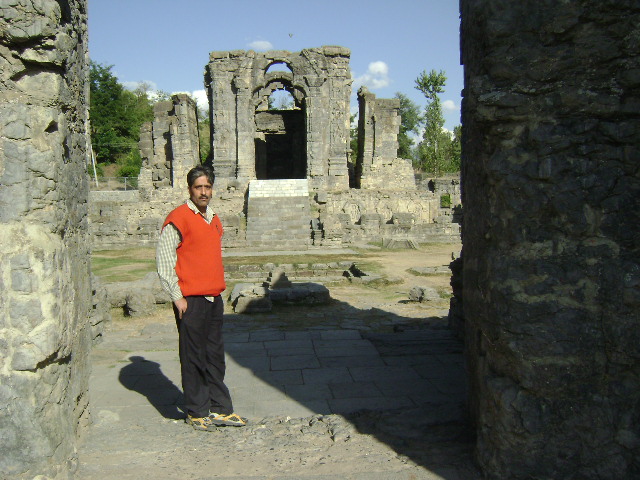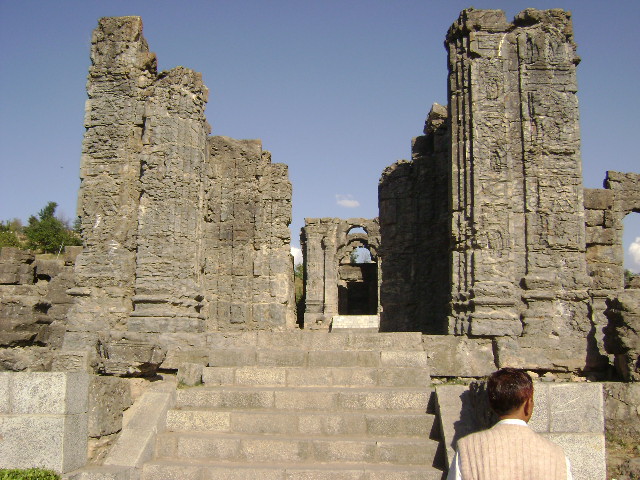Martand Mandir
by Chander M. Bhat
Martand Mandir, also known as Martandeshwar Mandir, now in ruins, is located
on the top of Mattan wudar in the East of Anantnag, just 2 km from Mattan, 4 km
from Anantnag and 63 km from Srinagar. The temple dedicated to Surya (the
Sun-god), is the only Sun temple in the north. Two other Sun temples are at
Konarak in Orrisa and at Modhera in Gujarat. The temple is considered not only
as an engineering marvel but also a magnificent architectural creation. The
ruins of this grand ancient temple are seen in a locality ahead of the present
Martand Tirtha, popularly known as Bhawan, which is in use since ancient times.
The shrine of Martand was a famous Tirthasthan in ancient times, which
finds a mention in Rajatarangini as well as in Tuzki Jahangiri. The
importance of this shrine is described in Martandamahatmya. According to
Aurel Stein, "The ancient remains at the sacred spring itself are very scanty.
All the more imposing are the ruins of the great temple, which King Lalitaditya
erected at a short distance in honour of the presiding deity of the tirtha. They
are situated a little over a mile to the south-east of 'Bhavan', near the
northern edge of the great Udar which stretches towards Anantnag". The
historians have not been able to establish the exact date of the erection of the
temple and there are variations, believed to be due to the presence of another
temple at the site, were the ruins of Martand temple stand today. Kashmiri
Pandits call it the house of Pandavas and Kauravas, thereby indicating that the
temple has a pre-historic origin and pertains to the period of Pandavas and
Kauravas. It is believed that Raja Ram Dev in 95 Kaliyug laid the foundation of
the temple and Raja Lalitaditya completed temple construction, though
Rajatarangini records only the colonnades of the temple as his work. Says
Lawrence "The true dates of erection of this temple….the wonder of Kashmir…is a
disputed point of chronology; but the period of its foundation can be determined
within the limits of one century, or between AD 370 and 500". The imposing
nature of the temple can be judged from the accounts given by various travelers
and historians and testified to some extent by the ruins and the remains of the
temple. Talking to the grandeur of the, temple Lawrence further says, "the
temple itself is not more than 40 feet in height, but its solid walls and bold
outlines, towering over the fluted pillars of the surrounding colonnade, give it
a most imposing appearance. Talking about the ruins, Aurel Stein writes, "Its
ruins, though much injured by the ravages of time and earthquakes, form still
the most impressive specimen of ancient Kashmiri architecture. Further, he says,
"The destruction of the sacred image is ascribed to Sikandar Butshikan".

Author in the temple complex, viewing the past glory.
According to Soon Adab, it took Sikandar Butshikan quite sometime to demolish
it. Martand consists of a courtyard with the principal shrine in the middle and
a colonnaded peristyle. The grandeur of the temple can be judged from the facts,
as under
-
The main temple is 63 feet in length, 36
feet in width. It is in the centre of the courtyard. The temple was raised on
a plateau and was visible from all sides around Martand.
-
The courtyard is 220 feet long by 142 feet
broad and contains eighty-four fluted columns facing the courtyard. The whole
structure is built on grey stones carved beautifully in those days by the
stone masons. Each stone is a big boulder and carved in such a way to give
shape of squares and circles.
-
The peristyle is externally plain, except on
the West side, which originally had a row of columns similar to that of the
Avantipur temples. It gives an indication that engineering art adopted at
Avantipur temple is similar to the one available at Martand.
-
The temple is divided into Ardhamandapa
(the outer portion) measuring 18 feet 10 inches square, Autarala (the
middle portion) measuring 18 feet by 4 ½ feet and Garbhagriha (the
inner portion) measuring 18 feet and 5 inches by 13 feet 10 inches. It is
believed that an idol of Sun-god was installed in Garbhagriha. It was a
perfect engineering marvel giving an indication that three gates were to be
crossed to reach the main temple. Thus the Hindu mythology of Aehlok,
Parlok and Pataallok are to be seen over here.
-
The entrance, or gateway, stands in the
middle of the Western side of the quadrangle and is the same width as the
temple itself. The walls of the gateway are profusely decorated and indicate a
welcome sign for the pilgrims who believe in the heavenly powers of Lord
Martand.
-
The outer periphery of the temple is 270
feet by 180 feet and has three main gates. This indicates that builders of the
temple wanted to show that Lord Martand has two eyes and the sixth sense to
watch the world.1

Main entrance to the temple - a path which leads to darshan of Lord Martand.
Notes and References:
-
Encyclopedia: Kashmiri Pandit:
Culture & Heritage by C.L. Kaul,
published by Ansh Publications, 2009.
Image Gallery:
http://ikashmir.net/gallery/categories.php?cat_id=157
| 